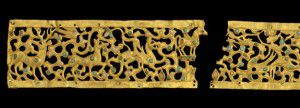In June of this year, Bolshaya Udina, a formerly extinct volcano in Eastern Russia was declared active due to increased seismic activity. Ensuing predictions of a Vesuvius size eruption sparked memories of Pompeii’s infamous demise in 79 A.D., an event that both archeologists and volcanologists are still working to fully dissect(Osborne 2019a). With the looming possibility of another large scale catastrophe, many are turning to those same researchers to uncover what Pompeii’s past can disclose about Bolshaya Udina’s future(Scandone et al. 2019).

Bolshaya Udina, the now active volcano with potential to cause Pompeii-like conditions(Gramling 2019).
Unfortunately enough, tensions between volcanologists and archeologists studying the site are hindering fruitful collaboration. Since the early eighteenth century, archeologists have been documenting the stratigraphic record of Pompeii, using the law of superimposition, stating that the lowest layers of a site form first, to understand the workings and development of Roman life in the city. Excavations yielding frescoes, mosaic tiles, fountains, and courtyards have revitalized the city, solidifying it as a dynamic archeological wonder that the world has remained fascinated with for centuries(Garcia-Navarro 2019). Still, a crucial element of the city’s history remains overlooked by the field: its demise.
In the pursuit of artifacts and features trapped within the ash sealed stratigraphy of the land, archeologists have been accused of destroying the evidence of volcanology. Volcanology uses volcanic deposits to explain how people died, and so, removal of these deposits in the excavation process is, essentially, ignoring elements of the stratigraphic record. Despite pleas from volcanologists to preserve the volcanic evidence, archeologists continue to cut through sites, regularly removing deposit layers(Osbourne 2019b).
The value of forgoing excavation or allowing volcanologists to oversee stratigraphic record keeping has been proven useful before. In the 1980s, studies of deposits in newly excavated sites, revealed that the people of Pompeii died from pyroclastic flow, a combination of volcanic gas clouds and magma. Before this volcanological study, however, it was assumed that pumice rain was responsible for killing Pompeii’s population. Thus, this breakthrough prompted a change in strategy for preparing for future eruptions(Osbourne 2019b). Today, the hope is to again use the two fields to understand how pyroclastic flows would sweep around existing buildings, so that current and future populations, like those near Bolshaya Udina, living in similar conditions can adapt accordingly(Solly 2019).
Though there is a trend of geologic history being destroyed for the sake of recording cultural history, progress is being made. Many volcanologists remain barred from entering archaeological sites in Pompeii, but agreements were recently made between researchers allowing volcanologists from the University of Naples Federico II to study stratigraphy alongside archeologists. With the goal of collaboration between the disciplines, volcanologists are being given access to study damage to victims of Vesuvius based on different eruptive stages by recording stratigraphy, taking samples, and mapping damage(Osborne 2019b).
With no projection of when Bolshaya Udina will erupt, we are simply left to wonder if an incomplete record of the past will fix itself in time to offer a useful vision for the future.
References
Garcia-Navarro, Lulu
2019 Volcano Experts and Archeologists are Clashing over Access to Study Pompeii. NPR, July 28, 2019.
https://www.npr.org/2019/07/28/745989999/volcano-experts-and-archaeologists-are-clashing-over-access-to-study-pompeii, accessed September 21, 2019.
Gramling, Caroline
2019 Is a long-dormant Russian volcano waking up? It’s complicated. ScienceNews, June 17, 2019.
https://www.sciencenews.org/article/dormant-russia-volcano-bolshaya-udina-waking-complicated, accessed September 21, 2019.
Osborne, Hannah
2019 Extinct Russian Volcano Has Woken Up and Could Unleash ‘Pompeii-Size’ Eruption, Scientists Warn. Newsweek, June 6, 2019.
https://www.newsweek.com/russia-extinct-volcano-woken-pompeii-eruption-1442479, accessed September 21, 2019.
Osborne, Hannah
2019 Pompeii Archaeologists Committing Vandalism to Volcanology by Destroying History Of Vesuvius Eruption, Scientists Claim. Newsweek, July 17, 2019.
https://www.newsweek.com/popmpeii-archaeologists-vandalism-vesuvius-eruption-1449676, accessed September 21, 2019.
Scandone, Roberto & Lisetta Giacomelli, Mauro Rosi, Christopher Kilburn
2019 Preserve Mount Vesuvius history in Pompeii’s. Nature, July 9, 2019.
https://www.nature.com/articles/d41586-019-02097-3, accessed September 21, 2019.
Solly, Meilan
2019 Why Archaeologists and Volcanologists Are Clashing Over Excavations at Pompeii. Smithsonian, July 24, 2019.
https://www.smithsonianmag.com/smart-news/why-archaeologists-and-volcanologists-are-clashing-over-excavations-pompeii-180972716/, accessed September 21, 2019.
Additional Reading
Digging Deeper into Pompeii’s Past
https://www.archaeology.org/issues/344-1907/features/7714-pompeii-new-investigations
Extinct volcano has woken up and scientists say it could erupt ‘at any moment’
https://www.cnn.com/2019/06/07/europe/russia-volcano-scli-intl-scn/
Did Vesuvius Vaporize its Victims?






















